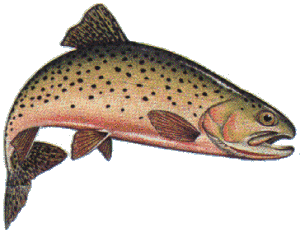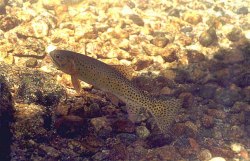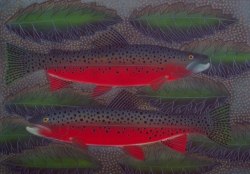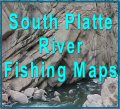A Success Story: Greenback Cutthroat
Oncorhynchus clarki stomias
by Karen Christopherson
The Greenback is one of 14 subspecies of Cutthroat Trout. The Cutthroats originally populated waters from southern Alaska to central New Mexico. They were the only native trout in the western US and were remarked upon in journals of explorers such as Lewis and Clark.
Cutthroats are descendents of coastal trout who worked their way inland as much as 2 million years ago. Possibly, they migrated up the Columbia River, into the Snake, and spread into the other large rivers of the west. The glaciations of the Ice Ages helped, providing changes in river courses and fluctuations in water levels. How did they get across the Continental Divide and major mountain passes? Good question - there are many theories on this.
The early explorers and native Americans had names for the cutthroats, but did not necessarily distinguish them from other trout. It was not until the 1880's that the trout got their name. A writer for American Angler, Charles Hallock, commented in an 1884 article about Montana fishing that, "Its distinctive feature, however, was a slash of intense carmine across each gill cover.....For lack of better description we called them cut-throat trout." The name stuck.

drawing of greenback courtesy of Colo. Div. of Wildlife
Original Range
The original range of the Greenback subspecies is difficult to determine, in part because it so closely related to the Colorado River Cutt, in fact it is descended from the CR Cutt. However, now the Greenback is that cutt considered native to drainages of the South Platte and Arkansas River systems. As exploration of the west continued, so did growth. And as people moved in, they wanted some of their favorite fish to angle for. Browns were introduced to Colorado in 1890, Brookies in 1872, and Rainbows in the 1880's. The cutthroats were not bred to compete with the larger and/or more aggressive trout. Other factors that added to the Greenback's demise were over-fishing (no catch and release in early Colorado) and loss of native habitat.
Recovery
By 1937, the Greenback was thought to be extinct. But two populations were discovered, and in 1959 efforts by many agencies were started to recover the Greenback to Colorado waters. In 1967, the Greenback was listed as an endangered species. Further successful efforts led to the downgrading from endangered to threatened in 1978. Recovery efforts included re-populating Greenbacks to streams and lakes with favorable habitat; removing other species from these habitats so that the Greenbacks wouldn't have to compete with other trout for food; harvesting semen and eggs for hatchery raising.

Photo by Peter Rissler. Courtesy of Biological Resources Research Center, Univ of Nevada, Reno
Today's Status
Today many stable populations of Greenbacks have been established. The Division of Wildlife and other groups have listed the Greenback as being present in 52 locations and 19 stable populations. And, the Greenback was named the official state fish of Colorado in 1994.
Catch and release fishing for Greenback Cutthroats is possible in locations including:
- Rocky Mountain National Park: North Fork Thompson River and numerous lakes
- San Isabel National Forest: Lake Fork Creek and numerous lakes
- Roosevelt National Forest: Sheep Creek and Zimmerman Reservoir
- Arapaho National Forest: Cornelius, George, and Bard Creeks
As you're fishing in these regions, keep your eyes open because you may find a Greenback in another water!
What do they look like?
Greenback cutthroats have the crimson slash under the jaw, the mark of a cutt. The Greenbacks have numerous black spots across the top of the greenish body and tail. The belly turns a bright crimson red during spawning season (in the spring and early summer). These cutts can live to be five years old in smaller rivers and up to ten years old in lakes.

Image of Greenbacks by Judy Hass. Judy's work is also featured on CFN's home and fishtail pages.
 Click
here to buy an Ebook about Trout on Colorado
State lands - includes a lot of info about many Colorado
fishing areas
Click
here to buy an Ebook about Trout on Colorado
State lands - includes a lot of info about many Colorado
fishing areas



